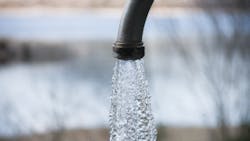EPA to strengthen regulations for lead in drinking water
Today, U.S. Environmental Protection Agency (EPA) announced that the agency will begin developing a new regulation to better protect communities from exposure to lead in drinking water. The agency plans to collaboratively work with local, state, and federal partners, to make rapid progress towards removing 100 percent of lead service lines, with a focus on prioritizing communities disproportionately impacted by lead contamination.
“Over the past year, I have visited with and heard from communities in Chicago, Flint, Jackson, and many other areas that are impacted by lead in drinking water,” said EPA Administrator Michael S. Regan. “These conversations have underscored the need to proactively remove lead service lines, especially in low-income communities. The science on lead is settled — there is no safe level of exposure, and it is time to remove this risk to support thriving people and vibrant communities.”
Following the agency’s review of the Lead and Copper Rule Revisions (LCRR) under Executive Order 13990, EPA concluded that there are significant opportunities to improve the rule to support the overarching goal of proactively removing lead service lines and more equitably protecting public health. EPA is announcing a two-prong approach to strengthen this regulatory framework.
Beginning December 16, the Lead and Copper Rule Revisions will go into effect to advance critical lead service line inventories that are necessary to achieve 100 percent removal of lead service lines. The agency plans to issue guidance — including best practices, case studies, and templates to help develop lead service line inventories — to assist its partners in implementation of the rule.
EPA will also develop a new proposed rule, the Lead and Copper Rule Improvements, that will strengthen the regulatory framework. EPA intends to propose requirements that, along with other actions, would result in the replacement of all lead service lines as quickly as is feasible. EPA also intends to consider opportunities to strengthen tap sampling requirements and explore options to reduce the complexity and confusion associated with the action level and trigger level, with a focus on reducing health risks in more communities. The goal of these potential lead service line replacement regulatory improvements — coupled with non-regulatory actions — is intended to protect public health more equitably.
Additionally, EPA will allocate $2.9 billion in Bipartisan Infrastructure Law funding to states, Tribes, and territories to remove lead service lines. This 2022 allocation is the first of five allotments that will provide $15 billion in dedicated funding for lead serve lines replacements. In addition to the dedicated investment in lead service lines, the Law provides an additional $11.7 billion in general funding through the Drinking Water State Revolving Fund, which can also be utilized for lead removal projects.
“This first-of-its-kind initiative will be remembered as one of the most significant public water and drinking water improvement initiatives in the country’s history and especially in rural America," said Matt Holmes, NRWA CEO, in a statement. "We are especially grateful that the funding is targeted to disadvantaged communities that often have the most difficult time affording safe, public drinking water and most disadvantaged communities will be in small-town and rural America.”
